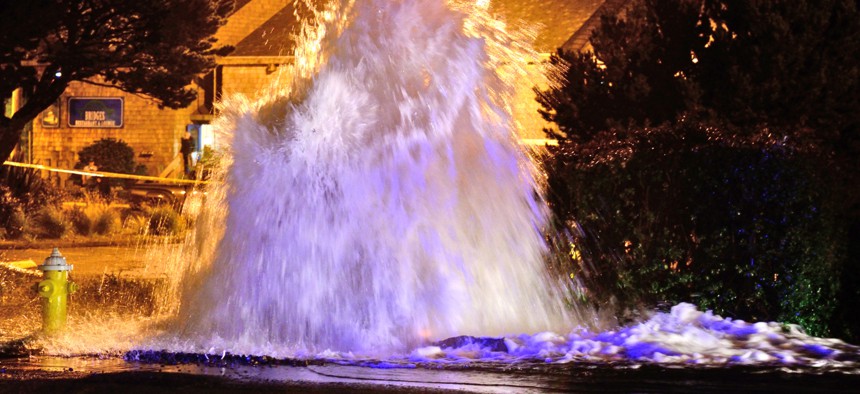Can ‘Mad Libs’ Save Our Failing Infrastructure?

An estimated 240,000 water mains burst every year in the United States. TFoxFoto / Shutterstock.com
A resiliency team takes an out-of-the-box approach to America’s least sexy problem.
A team of resiliency experts built a toolkit to help small to midsize cities think outside the box when it comes to procurement. Why you might ask?
“We think procurement is a cornerstone of resilience,” Dr. Shalini Vajjhala, founder & CEO of re:focus partners and head of the project, told Route Fifty. While Vajjhala admits procurement might not sound sexy, it is fundamental to how government approaches problems and, therefore, tackling it is one of the best ways “to make an impact on things like climate change [and] protecting cities from disasters.”
The Kresge Foundation agreed, funding the private sector cohort’s project as team members worked with seven cities to create the toolkit.
There are no shortage of “hamster wheel” issues in local government, where leaders feel the only solution is to pour more money and time in to keep up with demand. Most of the problems that fall under the heading of “resilient cities” likely top that list.
Take America’s failing infrastructure. The public certainly knows our decaying infrastructure is a problem: seventy-one percent of Americans support increasing federal spending for infrastructure, and three-in-four people supported President Trump’s proposal to spend one trillion dollars on infrastructure in April 2017.
Despite public support, though, that chunk of money is not coming anytime soon. And even if it did materialize, one trillion dollars in federal infrastructure largess would hardly make a dent.
One million miles of pipes supply fresh drinking water to U.S. residents every day. Those pipes alone will require a trillion dollars in maintenance over the next 25 years, according to the American Society of Civil Engineers. And that’s before communities even addressing dams, bridges, transit and wastewater systems.
Part of the problem, according to Vajjhala, is “it’s easiest to buy things you already have from people you already work with.”
For instance, when local water systems fail (an estimated 240,000 water mains burst every year in the United States), local governments tend to choose “bolt-on” repairs that fix the problem for another 20 years, going through the same purchasers and purchasing. Cities are just replacing legacy infrastructure everyone acknowledges does not work well with more of the same, Vajjhala said.
“The challenge here is procurement is defensive, it is designed to protect against waste, fraud and abuse,” she said. “If you start with what you can’t do, you’ll live within those limits in a way that may not be necessary.”
What is much more difficult and rare is cities finding a way to get off that hamster wheel, or as Vajjhala puts it, “zooming out far enough that you create space for innovation.”
Larger cities have been successful in ‘zooming out’ with civic challenges and creative procurement. New York has used civic challenges to try to reduce waste in the city and build vibrant neighborhoods. Washington, D.C. is hoping to have participants create Gigabit-fueled city mobility and environmental solutions. On the other coast, Seattle is using performance-based contracts to improve services for the homeless population and the San Francisco Bay area just completed a design challenge to get innovative ideas to stop flooding.
However, what works for these major cities is not always accessible to smaller jurisdictions, many of which have budgets and personnel levels that resemble a small department in some of America’s largest metropolises.
“We were hearing from many of our partner cities—the small and medium-sized partner cities particularly—that they were interested pursuing these procurement tools… but had literally no idea where to start,” Ellory Monks, a co-founder of The Atlas, a company that hosts an online community to help cities become “safer, smarter and more sustainable,” who also worked on the toolkit.
Borrowing from the Ansari X-Prize that set off the race for commercial space flight some two decades ago, the toolkit takes a “Mad Libs” approach to helping cities create a problem statement that allows them to determine “what elements of the problem are most critical to solve.”
Next, the toolkit looks to identify the right tool to bring the right solution providers to the table – whether it be a private company, NGOs or other service providers. Sometimes a traditional procurement is the right way to go—and it is usually the easiest path. However, often this means leaving out innovative ideas that may be outside the normal community members.
For the testing and creation of the toolkit, the team focused on legacy water systems, because it seemed to be a quintessential hamster wheel problem.
“The way we are doing things now are really not going to work in the future, but we need to attract new partners,” Monks said, ticking off a litany of statistics and stories about pipes bursting, nuisance flooding, roads collapsing and water systems being used well beyond their lifespan. “As water utilities and cities are looking to replace and upgrade those failing systems, there’s a huge opportunity for them to do things better.”
Participants from El Paso who worked on the toolkit found ways to be more creative in addressing a history of devastating flooding.
“We don’t have a lot of stormwater infrastructure; our roads carry our water,” Lauren Baldwin, former sustainability director for the city, said in an interview describing nuisance flooding, and the deterioration of roads that followed, as a major headache for the city and its residents. Baldwin said in helping craft the toolkit the El Paso participants realized that they could address one of senior officials’ most nagging issues and pay for green infrastructure at the same time.
“Potholes are one of the number one calls they receive,” she said. “Everything in our life is potholes.”
Baldwin says El Paso now has a long-term strategy to move toward outcome-based procurement for green infrastructure. It starts with securing funding for a small number of sites to build resilient, absorbent landscaping “bioswales” that will help catch water before they get on the road—and therefore prevent future potholes. By analyzing the data from those, they are hoping to secure a financial partner to help convert those savings from the green infrastructure into more throughout the city.
Baldwin said the team only had a “baby level” idea of what they wanted to do beforehand. The much more flushed out plan is “appealing to leadership because we are finding solutions when other people are [just] constantly talking about issues we have, the increase in maintenance costs we have.”
Camden County Municipal Utilities Authority Executive Director Andy Kricun, who runs the water systems for the city of Camden, also found new ways of tackling already identified problems. Camden was able to find a “viable, affordable approach to implementing a microgrid for green and resilient energy in Camden City,” which may help them go beyond their goals of 100 percent off the grid by 2020. With the new approach, Kricun believes the utility will be able to “generate more electricity than we need … to send that out to vulnerable infrastructure in Camden – drinking water plants, schools, hospitals.”
His agency has also wanted to do more to identify and replace lead pipes that could potentially be harming residents, but knew lead problems went beyond pipes owned by the authority itself. Participation in the toolkit creation lead Camden to consider a low-interest rate, long-term financing program that could span both utility-owned lines and indoor plumbing owned by others that are often the source of exposure.
Baldwin is not a fan of toolkits generally (“You hear about toolkits all the time, we’re over toolkits,” she said). But she found the work of the team at re:focus partners and The Atlas different because it was so eminently practical.
As for Vajjhala and her team, they are hoping that other cities will start to explore the sort of innovation that has generally been the domain of big cities.
“We’re trying to create progress, not perfection,” Vajjhala said. “Resilience is not just about creating a strategy; it’s about knowing where the lily-pads are to make it all the way across the river.”
Mitch Herckis is Senior Editor and Director of Strategic Initiatives for Government Executive's Route Fifty and is based in Washington, D.C.
NEXT STORY: Plans to Build Massive Wall to Protect Texas Move Forward






